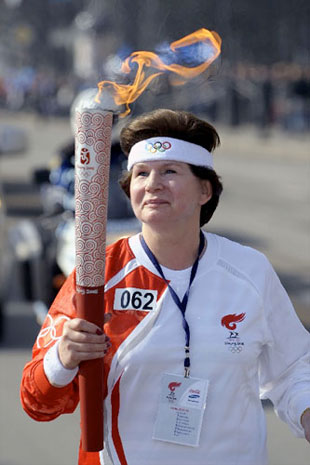[/caption]
Space and the Olympics might not be synonymous in most people’s minds — although this image of the Opening Ceremony fireworks makes it look like Olympic Stadium is going supernova — but there are a few connections between the two for this year’s Summer Olympics in Beijing, China. Google Earth recently updated the satellite imagery it uses for the Beijing area to provide users with better maps. They also used satellite imagery to create a 3-D tour of all the facilities for the 2008 Olympics (see video below). Other space connections include several space explorers who carried the Olympic torch on its running tour around the world, and NASA space spinoff technology used in some of the clothing and equipment for Olympic use.
The first woman in space, Russian cosmonaut Valentina Tereshkova, one of 80 Russian runners, carried the Olympic torch during its tour of that country in early April. Sheikh Muszaphar Shukor, the first Malaysian in space, ran with the torch along the top of Kuala Lumpur Tower on April 21, just six months after his visit as a “spaceflight participant” to in International Space Station. Fittingly, several Chinese taikonauts carried the torch: Fei Junlong and Nie Haisheng, the two-man crew from China’s second spaceflight, Shenzou 6 ran with the torch when it arrived in China in May. China’s first space explorer, Yang Liwei who flew solo on Shenzou 5 in 2003, carried the torch when it first arrived in Beijing on August 6.
While no US astronauts carried the torch, NASA astronaut Scott Parazynski was at Base Camp when Chinese climbers carried the torch to the summit of Mt. Everest on May 8.
NASA developed “riblet” technology to aid in the aerodynamic properties of airplanes. Riblets are V-shaped grooves with angles that point in the direction of the air flow. They are no bigger than a scratch, and they look like very tiny ribs. Riblets help reduce “skin-friction” drag. But it also helps reduce friction from water, and riblets have been used in rowing shells in the four-oar-with-coxswain category. Swimsuits with riblets have also been used in competition at the Pan American games.
And of course, everyone is probably familiar with the lore that today’s athletic shoes use the same cushioning technology that was developed for the moon boots used in the Apollo missions to the moon.
News Sources: Collect Space, Kodak Olympic Picture of the Day, NASA Goes to the Olympics




Oh, please. I thought this was suppose to be about astronomy. You know, the study of the cosmos?
“Oh, please. I thought this was suppose to be about astronomy. You know, the study of the cosmos?”
Well, if you want to be strict about it, Universe Today is a title that covers a lot of ground. 🙂
Did you know that the 4 year cycle of Olympics games is due to the 4 year cycle of venus ?
I agree, Aaron F., It could be argued that the Olympics are of “universal” interest. I bet there wouldn’t be any negative comments if the Games were held on another world.
Cool article. I’m still fascinated how NASA techology was used in the development of swimsuits. Is the lore about shoes true?
@RL- it’s all true!
Cheers,
Nancy
Interesting article Nan! See ya soon. 🙂
“Well, if you want to be strict about it, Universe Today is a title that covers a lot of ground”
Yes. I’m reminded of the assertion that you can see (appropriately) the Great Wall ‘from space’ without explicitly saying what they mean by that.
From LEO? (and let’s call that lower than 300 miles) Sure.
From the Moon (as some phrase it)? Not with the naked eye, I’m thinking.
Remember, ‘space’ without any qualifier means the entire UNIVERSE, except for the first 100km or so around this one planet….
Remember, you can step into the surf off Alaska and someone else do the same off New Zeland, and you’re both ‘in the Pacific Ocean.’ But hardly in shouting distance of each other.
(And don’t get me started on how presumptive a pagent calling itself ‘Miss Universe’ is.
I know a planet of a K6 class star in one of the outer arms of the Andromeda galaxy that has *much* hotter women than we do…! 🙂 )